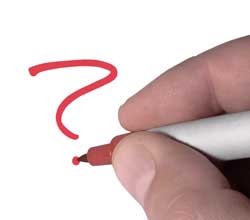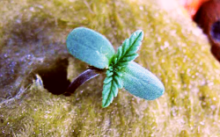You are herePPM: What It Is and How To Track It
PPM: What It Is and How To Track It
 If you’ve ever tried to learn how to grow cannabis via cannabis growing forums, you’ve probably seen a few terms thrown around that confuse newcomers.
If you’ve ever tried to learn how to grow cannabis via cannabis growing forums, you’ve probably seen a few terms thrown around that confuse newcomers.
One that you’ve most undoubtedly seen is “ppm”.
If you’re like me, you’ve probably avoided learning about this term altogether as it seems to add another layer of complexity to cannabis growing.
Today, I will clear up some of the most common questions on the subject, such as what ppm is, what a TDS meter has to do with all this, and some other info so that you will be impowered with new knowledge. It’s really simple once you have the hang of it!
Read on to upgrade your growing knowledge!
What IS PPM?
PPM is an acronym for Parts Per Million, and when this term is used in cannabis cultivation, it refers to the concentration of solubles (minerals) in the water you give your plants. This is a way for growers to refer to exactly how much minerals and other substances are in their water which is is useful since plants can only intake so much at a time. This is also useful for DWC growers who need to know the current condition of their reservoir water.
1 part per million is the equivalent of 1mg of solubles per liter of water which is a miniscule amount to measure! Drinking water tested in the US can measure as low as 0 (for reverse osmosis, or distilled water) or as high as 700 (poor quality tap water; old, out-of-shape pipes), but most tap water will fall in the 200ppm-400ppm range.
Simply put, a TDS meter is the tool a grower would use to measure the ppm in the water they’re checking.
There are many TDS meters of varying cost and abilities; some also measure temperature or have hold buttons, some measure a higher range of ppms than others.
For those looking into purchasing a TDS meter, know that the range of ppm a particular meter measures shouldn’t be much of a factor for you. Some TDS meters measure up to 5000ppm and some go up to 9999ppm, but for cannabis cultivation, you will rarely see anything above 3500ppm. In fact, in all of the General Hydroponics feeding schedules, the highest ppm is calls for is 1500ppm max. This doesn’t mean you need a meter that only reads up to 1500ppm, but it does mean the ability of a meter to read over 5000ppm isn’t needed.
What Is a EC Meter?
 EC meters measure the electrical conductivity of the water they’re testing. This reading is useful for...measuring the amount of solubles in your water!
EC meters measure the electrical conductivity of the water they’re testing. This reading is useful for...measuring the amount of solubles in your water!
So what’s the difference between a TDS meter and an EC meter?
When it comes to growing cannabis, there isn’t much of a difference at all. In fact, many TDS meters actually measure the electric conductivity of liquids, and then convert those results into ppm. In other words, many TDS meters are actually EC meters in disguise!
Electrical conductivity is measured in S/m (siemens per meter; no giggling!), but since we’re dealing with stuff on such a miniscule scale, readings will show up as μS (micro - or one millionth - siemens per meter) or mS/m(milli - or one thousandth - siemens per meter).
Although EC meters function just as well as TDS meters, I would strongly recommend against getting one. Most feeding charts or sources of information that talk about water quality will give measurements in ppm. EC meter readings (mS/m) can easily be converted to ppm, but you’ll save yourself some trouble by starting in the right unit of measurement.
Do I Really Need To Measure PPMs?
 For a large part of my growing career I ignored using a TDS meter or even learning what they do. Although I don’t recommend that strategy as a way to deal with any problem, I can say that I still managed to grow sticky, potent bud despite my resistance to learn.
For a large part of my growing career I ignored using a TDS meter or even learning what they do. Although I don’t recommend that strategy as a way to deal with any problem, I can say that I still managed to grow sticky, potent bud despite my resistance to learn.
In short, I’m confident that anyone can grow a beautiful set of plants from seed to harvest without ever needing to invest in a TDS meter.
However, having a TDS meter can help to prevent or solve problems with nutrient burn and/or overfeeding your girls. If you frequently find that your plants suffer from nutrient burn despite giving them a very small amount of nutrients, you might want to invest the $25 or so to get a TDS meter. Note: If you get a TDS meter, you are definitely going to need calibration solution to make sure the meter is giving you proper readings. I recommend 1000ppm calibration solution which will cost about $10.
How To Measure PPM
This is actually an easy process!
- Get a TDS meter. I recommend the HM Digital AP-1 as it’s cheap, it has a few handy features(hold button, on screen temperature), and it doesn’t seem to need recalibration often if at all.
 Get calibration solution. This isn’t absolutely necessary, but I would definitely recommend it as sometimes meters come out of the package needing calibration.
Get calibration solution. This isn’t absolutely necessary, but I would definitely recommend it as sometimes meters come out of the package needing calibration.- Calibrate your TDS meter. Instructions will be on the package; the whole process takes 1 -3 minutes.
- Turn on the TDS meter, wait for it to read zero, and insert the electrode into the water you’re testing. If you have a hold button, press it to lock the ppm in. If not, make a note of what the meter reads.
That’s it! You now have the ppm of the water you’re testing. Keep in mind this can be done to several things to give you helpful information:
- Your tap water
- This way you know what’s in your water before you add nutrients to it.
- Your nutrient water
- Make sure you’re not giving your plants water that will (nutrient) burn them.
- DWC/Top Fed DWC Reservoirs
- Make sure the nutrient concentration in your reservoir isn’t spiking as the amount of water goes down.
What To Do With This Information
Once you have your ppm, you can make proper adjustments to get it in the desirable range. Speaking of which, you’re going to need to know what ppm range you want for your water. This can vary depending on which nutrients you use, but here are some good guidelines:
- Tap water: 400ppm or below; 400 is high for tap water.
- Nutrient Water: 500ppm - 800ppm total
- DWC Reservoir water: 800ppm - 1500ppm
Now that we have our goals, we can make the proper adjustments to get the ppm to where it should be.
Tap water ppm is too high:
- There are several home options available which can drastically lower the ppm in your tap water. Some of these include carbon filtering, distillation, and reverse osmosis. Keep in mind that some processes clean the water so effectively, that you'll need to add calcium/magnesium back into the water.
Adding a normal amount of nutrients makes ppm too high:
- Try using nutrients made for “hard water”(water with a high concentration of minerals), such as Flora Micro Hard Water. This will lower the overall ppm.
DWC Reservoir ppm is too high/low:
- Too high: Add plain ph’d water to the reservoir and test. Repeat until your reservoir reaches a safe fill point, or the ppm is in the correct range. If the ppm is still too high, you can wait for the plant to lower the water levels, or you can change the reservoir water altogether.
- Too low: Do the same as you would if the ppm were too high, but instead, fill with nutrient-rich water.
Everything You Need to Know Your PPM
HM Digital AP-1 TDS Meter: Cheap, feature rich, and powerful!
342ppm Calibation solution; for low ppm measurements
1000ppm Calibation solution; for low high measurements
Interested in growing huge yields with Top-Fed DWC? Check out how I do it!






